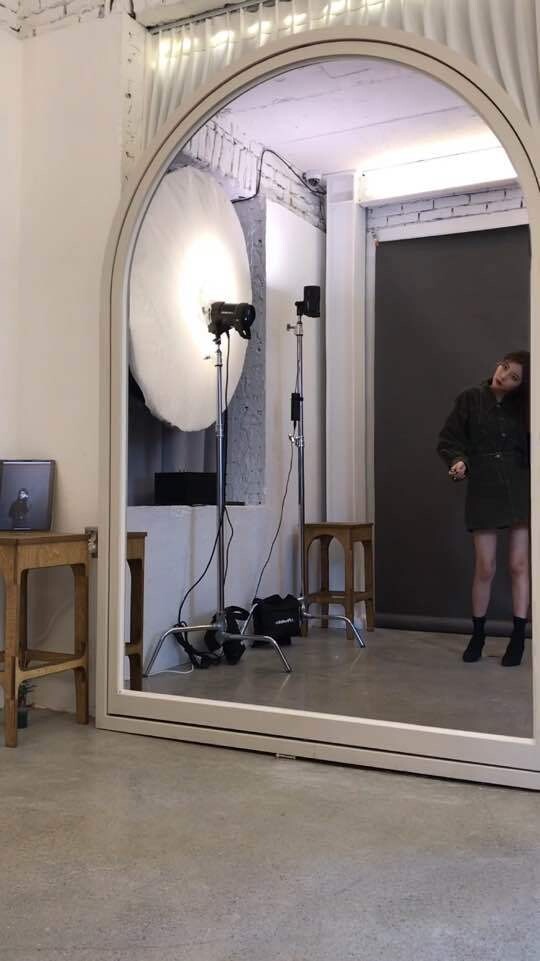hankyoreh
Links to other country sites 다른 나라 사이트 링크
The rise of “self-photography” among Korean youth

Han Ji-su, 25, stood in front of the mirror by herself, holding a traditional Korean instrument known as a saenghwang in a studio measuring 13.2 square meters. Taking out a Bluetooth speaker and turning on a piece of fusion gugak (traditional Korean music) that she had composed herself, she began to play the instrument in front of the mirror. A light flashed, and a photograph of her playing appearing on a monitor surrounding her. No photographer was visible. It was Han herself who decided the image’s composition and press the shutter by remote at the desired moment.
Among young South Koreans who prefer the single life, the coinages “honbap” and “honsul” have been respectively used to refer to those who enjoy eating meals or enjoying drinks alone. Now a new term has been added to the list: “honsa,” or people who take pictures on their own. Rather than relying on photographers, they rent their own photography settings and take pictures freely with props they prepare on their own. Nearly 10 photography studios offering “self-photography” services have popped up in Seoul alone.
Han, who had taken several profile pictures of herself in the past for recitals, visited one of these self-photography studios in the Yeonnam neighborhood of Seoul’s Mapo District on Nov. 6. While she had had pictures taken by a professional in the past for a hefty fee, she decided what she needed was a picture that would capture her true self, rather than the kinds of uniform images a professional photographer asks for. “I felt like the image of myself that others see and what I am inside are different,” she said. “Since I’m by myself, I can try whatever I feel like during the time I get.”

Sajin Onsil (Photography Greenhouse), a self-photography studio that opened in Yeonnam last July, has one of its walls set up as a “half mirror,” with no camera visible. The results can be immediately seen, but the camera itself is hidden behind the mirror, which helps to ease the tension for the “subject.” Users pay 80,000 won (US$68.72) for a 20-minute session, taking anywhere from 80 to 120 pictures. The fee is not cheap, but over 40 reservations have been booked for this month alone. In just four months, the business has already achieved a measure of success. Its president, artist Lee Sang-jae, said, “Since the ones taking the pictures at the existing studios are professional photographers, it’s not easy to capture the essence of the person in the pictures. I think a lot of people visit who think that the natural expression from that moment when we look at ourselves in the mirror is what’s truthful.”
Lee explained that users of the self-photography studio simply need to look at themselves in the mirror rather than the camera during their session. In that sense, the format is different from standard mobile selfies, which often distort the user’s image through exaggerated filters. Kim Hyeon-sik, who runs the self-photography studio Mullamu in Seoul’s Gye-dong neighborhood, explains, “About 80% of people cry while they’re taking pictures. They say a lot of thoughts go through their heads while they’re looking in the mirror before pressing the shutter.”
Lee Su-ji, 26, an illustrator who captures images of her ballet pastime at the self-photography studio, said she went there to take pretty pictures and ended up finding herself.
“I was a bit anxious, thinking it would come out prettier if a photographer took the picture,” she explained. “But rather than feeling stressed about providing a better pose, I was able to capture myself looking comfortable, even if it wasn’t a perfect pose or perfectly pretty.”
By Bae Ji-hyun, staff reporter
Please direct comments or questions to [english@hani.co.kr]

Editorial・opinion
![[Guest essay] The real reason Korea’s new right wants to dub Rhee a founding father [Guest essay] The real reason Korea’s new right wants to dub Rhee a founding father](https://flexible.img.hani.co.kr/flexible/normal/500/300/imgdb/original/2024/0423/8317138574257878.jpg) [Guest essay] The real reason Korea’s new right wants to dub Rhee a founding father
[Guest essay] The real reason Korea’s new right wants to dub Rhee a founding father![[Column] ‘Choson’: Is it time we start referring to N. Korea in its own terms? [Column] ‘Choson’: Is it time we start referring to N. Korea in its own terms?](https://flexible.img.hani.co.kr/flexible/normal/500/300/imgdb/original/2024/0423/3617138579390322.jpg) [Column] ‘Choson’: Is it time we start referring to N. Korea in its own terms?
[Column] ‘Choson’: Is it time we start referring to N. Korea in its own terms?- [Editorial] Japan’s rewriting of history with Korea has gone too far
- [Column] The president’s questionable capacity for dialogue
- [Column] Are chaebol firms just pizza pies for families to divvy up as they please?
- [Column] Has Korea, too, crossed the Rubicon on China?
- [Correspondent’s column] In Japan’s alliance with US, echoes of its past alliances with UK
- [Editorial] Does Yoon think the Korean public is wrong?
- [Editorial] As it bolsters its alliance with US, Japan must be accountable for past
- [Guest essay] Amending the Constitution is Yoon’s key to leaving office in public’s good graces
Most viewed articles
- 1[Column] ‘Choson’: Is it time we start referring to N. Korea in its own terms?
- 2Senior doctors cut hours, prepare to resign as government refuses to scrap medical reform plan
- 3[Guest essay] The real reason Korea’s new right wants to dub Rhee a founding father
- 4Why Korea shouldn’t welcome Japan’s newly beefed up defense cooperation with US
- 5[Column] The clock is ticking for Korea’s first lady
- 6Opposition calls Yoon’s chief of staff appointment a ‘slap in the face’
- 7New AI-based translation tools make their way into everyday life in Korea
- 8Terry Anderson, AP reporter who informed world of massacre in Gwangju, dies at 76
- 9Korean government’s compromise plan for medical reform swiftly rejected by doctors
- 10[Editorial] Japan’s rewriting of history with Korea has gone too far